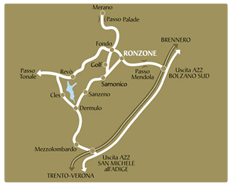Location
Where we are
To visualize the route from your own address please click 'A qui' and write your full address or enlarge the map.
Valle di Non
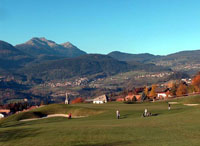 The Valle di Non is not a valley. This may seem like a paradox, but it is not, if what defines a valley is the classic concave form with two slopes and a river which runs through it. The Valle di Non, in the western part Trentino, is not like this, it is an exception to the rule. The Anaunia, this is its historical-literary name, is illuminated, hilly and full of life. Its mountains have no limits and tend to widen the valley; the horizon is distant. It is a sensation which is immediately noticed upon leaving the Valle dell'Adige at the Rotaliana plains and entering through the narrow Rocchetta ravine.
The Valle di Non is not a valley. This may seem like a paradox, but it is not, if what defines a valley is the classic concave form with two slopes and a river which runs through it. The Valle di Non, in the western part Trentino, is not like this, it is an exception to the rule. The Anaunia, this is its historical-literary name, is illuminated, hilly and full of life. Its mountains have no limits and tend to widen the valley; the horizon is distant. It is a sensation which is immediately noticed upon leaving the Valle dell'Adige at the Rotaliana plains and entering through the narrow Rocchetta ravine.
Click here to open the photo legend of the valley
The picture will open in a pop-up. Please allow it if your browser blocks pop-ups.
Click the picture to enlarge.
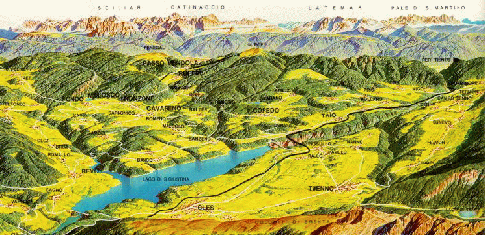 Here we come upon a large amphitheatre, a spacious stage with nature as the lead character. The plateaus rise gently, the rich apple orchards gradually make way for the thick coniferous forests, from sunny meadows to majestic mountains. Great mountain chains such as the Brenta and the Ortles-Cevedale alternate with smaller peaks such as the Anauni, Peller, Roen, Macaion, Maddalene and Mount Luco. These mountains surround and protect the territory from cold, northerly winds and assure a gentle a favourable climate. The valley is rich in water: pleasurable alpine lakes, the artificial lake of Santa Giustina, the Noce river which carves a narrow canyon, but most of all, an infinite number of springs and streams. Water is crystal clear, fresh and pure and runs vivaciously through the gorges which distinguish the morphology of the landscape - a great contrast to the harmonious and subtle plateaus. Nature is the great protagonist and is protected by the wisdom of the people of these mountains. Today, nature means hospitality and therefore, tourism. This valley has a long tradition of hospitality and human kindness, which transmit a sense of friendship and familiarity.
Here we come upon a large amphitheatre, a spacious stage with nature as the lead character. The plateaus rise gently, the rich apple orchards gradually make way for the thick coniferous forests, from sunny meadows to majestic mountains. Great mountain chains such as the Brenta and the Ortles-Cevedale alternate with smaller peaks such as the Anauni, Peller, Roen, Macaion, Maddalene and Mount Luco. These mountains surround and protect the territory from cold, northerly winds and assure a gentle a favourable climate. The valley is rich in water: pleasurable alpine lakes, the artificial lake of Santa Giustina, the Noce river which carves a narrow canyon, but most of all, an infinite number of springs and streams. Water is crystal clear, fresh and pure and runs vivaciously through the gorges which distinguish the morphology of the landscape - a great contrast to the harmonious and subtle plateaus. Nature is the great protagonist and is protected by the wisdom of the people of these mountains. Today, nature means hospitality and therefore, tourism. This valley has a long tradition of hospitality and human kindness, which transmit a sense of friendship and familiarity.
Ronzone
(altitude: 1084 m a.s.l.)
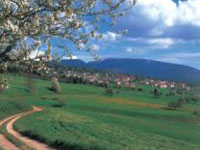 The present structure of Ronzone is the result of rebuilding the village after the fire that broke out in 1891. This winter and summer tourist resort was built a century ago along with the structure of one of the first hotels, "The Queen of the Woods", a hunting residence of the Hapsburg Court. Ronzone, beautifully sited, has a wonderful sunny open position overlooking the entire valley.
The present structure of Ronzone is the result of rebuilding the village after the fire that broke out in 1891. This winter and summer tourist resort was built a century ago along with the structure of one of the first hotels, "The Queen of the Woods", a hunting residence of the Hapsburg Court. Ronzone, beautifully sited, has a wonderful sunny open position overlooking the entire valley.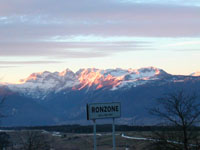 The village is divided between the old part on the south and the tourist-residential with small houses and modern jointly-owned buildings in the north. In the centre rises the new Parish Church in modern Romanesque style with its high pointed bell tower, decorated in the typical Anaunia tradition and separated from the main building. Inside, there is a Way of the Cross by Bonacina, who is also the author of the pictures at the bottom of the apses. Near by rises the old holy building, consecrated at the first moment to the Immaculate Conception, and following to St. Anthony. Remembered for the first time in the 14th century; then being seriously damaged during the afore-mentioned fire. Between the two churches, a small chapel (1692 - '93) is seen which preserves a precious and anatomically perfect Christ at the Column, a life-size wooden structure probably realized at the School of Cavalese.
The village is divided between the old part on the south and the tourist-residential with small houses and modern jointly-owned buildings in the north. In the centre rises the new Parish Church in modern Romanesque style with its high pointed bell tower, decorated in the typical Anaunia tradition and separated from the main building. Inside, there is a Way of the Cross by Bonacina, who is also the author of the pictures at the bottom of the apses. Near by rises the old holy building, consecrated at the first moment to the Immaculate Conception, and following to St. Anthony. Remembered for the first time in the 14th century; then being seriously damaged during the afore-mentioned fire. Between the two churches, a small chapel (1692 - '93) is seen which preserves a precious and anatomically perfect Christ at the Column, a life-size wooden structure probably realized at the School of Cavalese.
What to do?
Sport thanks to a football field, some tennis courts, a volleyball and a basketball court, an outdoor swimming pool and a children's playground. From Ronzone starts lots of promenade in the forest and mountain bike routes. In 2008 will begin the construction of a brand new acquatic center with swimming pools and Spa. The complex will open in 2010.
Il Canyon di Fondo
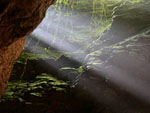 Una recente e suggestiva meta turistica della valle è rappresentata dall'incredibile spettacolo del canyon di Fondo. Escursioni con guida ed attrezzatura sono organizzate giornalmente al fine di scoprire la bellezza della roccia dolomica fin nelle viscere della sua costituzione. Per maggiori informazioni è possibile visitare il sito web del comune di Fondo.
Una recente e suggestiva meta turistica della valle è rappresentata dall'incredibile spettacolo del canyon di Fondo. Escursioni con guida ed attrezzatura sono organizzate giornalmente al fine di scoprire la bellezza della roccia dolomica fin nelle viscere della sua costituzione. Per maggiori informazioni è possibile visitare il sito web del comune di Fondo.
In the outskirtses...
The Region is very rich of vegetal species, which are typical of the Alpine environment, as the beech, the silver fir, the red-deal, the larch, the Swiss stone pinetree, the mountain pine, the rhododendron, the rowan tree, to mention just a few. Fauna is represented by deer, chamois, roe-deer, hares, eagles, grouses and other types of this species who find in the valley surroundings their natural habitat. For a dive into nature the ideal thing is to visit the two Parks of Stelvio and Adamello-Brenta.
Stelvio National Park
It occupies a surface of 95,000 ht between the Province of Trento, Bolzano and Sondrio. Countless are the natural guided itineraries. Pls apply to the visitors centre of Rabbi Valley (40 km from Fondo).
Adamello-Brenta National Park
Set up in 1967, you can access to it from the part of Tovel Lake where there's a visitors centre. It has a surface of 61,862 ht and includes almost entirely the Brenta Dolomites and part of Adamello Presanella . In the Park heart you'll find the enchanting Genova Valley, where the brown bear till lives today. It's an independent Board since 1989, regulated and financed by Province laws.
Tovel lake
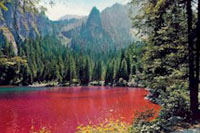 It's the king of the Alpine Lakes in the Park and the natural heart of the Brenta Dolomites. It's famous for the strong red colour it assumed until 1964 thanks to the micro-organism 'Glenudinum Sanguinium', still here in its waters, but in inferior quantity. It remains anyway one of the most well-known spots thanks to its extraordinary landscape and natural beauty. The road to the lake goes through the Brenta Group from Tuenno.
It's the king of the Alpine Lakes in the Park and the natural heart of the Brenta Dolomites. It's famous for the strong red colour it assumed until 1964 thanks to the micro-organism 'Glenudinum Sanguinium', still here in its waters, but in inferior quantity. It remains anyway one of the most well-known spots thanks to its extraordinary landscape and natural beauty. The road to the lake goes through the Brenta Group from Tuenno.
Other promenades
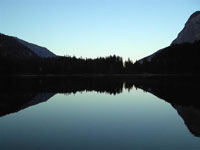 Dal nostro hotel, inoltre, i nostri clienti sono soliti seguire itinerari consigliati dalla direzione che possono comprendere tutto l'arco alpino trentino (una giornata, comprendente val d'Adige, lago di Monticolo, passo Sella, passo Palade, Cornaiano, ecc.) oppure il più breve tour della Val di Non (mezza giornata, lago di Tovel, lago di S. Giustina, San Romedio, Castelli, ecc.). Altre mete di rilievo sono i monti circostanti (Roen, Penegal, Luc, ecc.) e centri urbani vicini quali Bolzano e Merano, con i loro mercatini e musei, Bressanone, con il nuovo centro acquatico "Acquarena" ed Innsbruch, con il museo dei cristalli Swaroski, il trampolino olimpico, il ponte Europa e molto altro. Vi invitiamo comunque a informarvi presso la direzione dell'hotel per ricevere consigli sugli itinerari migliori per le vostre esigenze.
Dal nostro hotel, inoltre, i nostri clienti sono soliti seguire itinerari consigliati dalla direzione che possono comprendere tutto l'arco alpino trentino (una giornata, comprendente val d'Adige, lago di Monticolo, passo Sella, passo Palade, Cornaiano, ecc.) oppure il più breve tour della Val di Non (mezza giornata, lago di Tovel, lago di S. Giustina, San Romedio, Castelli, ecc.). Altre mete di rilievo sono i monti circostanti (Roen, Penegal, Luc, ecc.) e centri urbani vicini quali Bolzano e Merano, con i loro mercatini e musei, Bressanone, con il nuovo centro acquatico "Acquarena" ed Innsbruch, con il museo dei cristalli Swaroski, il trampolino olimpico, il ponte Europa e molto altro. Vi invitiamo comunque a informarvi presso la direzione dell'hotel per ricevere consigli sugli itinerari migliori per le vostre esigenze.
Sacred places
Churches
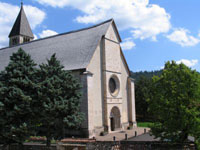 Trentino and Valle di Non in particular represent a magic meeting point of culture, amusement, traditions, nature and mysticism, different aspects making up a wonderful atmosphere. We will introduce to you Valle di Non in a particular light, such as priviledged religious destination and we will lead you along an interesting itinerary among sacred places, witnessing the deeply rooted faith of the Trentino people, who experienced a 800 year long bishops' government.
Trentino and Valle di Non in particular represent a magic meeting point of culture, amusement, traditions, nature and mysticism, different aspects making up a wonderful atmosphere. We will introduce to you Valle di Non in a particular light, such as priviledged religious destination and we will lead you along an interesting itinerary among sacred places, witnessing the deeply rooted faith of the Trentino people, who experienced a 800 year long bishops' government.
The sanctuary of San Romedio
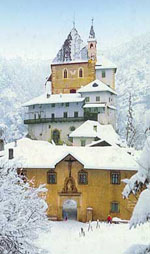 A dizzy pyramid of churches built one upon another and linked by a steep stairway of 131 steps set up the Sanctuary of St. Romedio.
Its particular architectural organization, extended towards the sky and clinging to a 70 metre high rock, among woods where deer and roe live, makes you immediately think of a fairy tale book which opens up and starts telling a story... Sir Romedio from the castle of Thaur, near Innsbruck, renounced his properties and, after a pilgrimage to Rome and thanks to his renewed faith in God, decided to retire to a cave not far away from the place where the first Christians sent to Valle di Non to preach the Gospel were killed in 397 A.D. Romedio found in this abode his new spiritual dimension and started looking differently at things and the other people surrounding him whom he called brothers and sisters.
A dizzy pyramid of churches built one upon another and linked by a steep stairway of 131 steps set up the Sanctuary of St. Romedio.
Its particular architectural organization, extended towards the sky and clinging to a 70 metre high rock, among woods where deer and roe live, makes you immediately think of a fairy tale book which opens up and starts telling a story... Sir Romedio from the castle of Thaur, near Innsbruck, renounced his properties and, after a pilgrimage to Rome and thanks to his renewed faith in God, decided to retire to a cave not far away from the place where the first Christians sent to Valle di Non to preach the Gospel were killed in 397 A.D. Romedio found in this abode his new spiritual dimension and started looking differently at things and the other people surrounding him whom he called brothers and sisters. 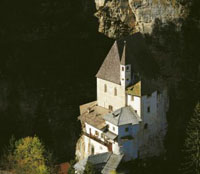 After his death his grave was dug in the rock, which ever since has been visited by many pilgrims. About the year 1000 A.D. those who had loved and esteemed him built the first church, starting off the sanctuary's construction. In the 12th century the cult of St. Romedio was officially recognized by the Bishop of Trento. Over the course of the centuries new pilgrims brought bricks and rocks setting up a shrine, which still inspires silence and meditation in the modern visitor. A penitential route marked by a Way of the Cross, realized in 1940, links the sanctuary with the basilica of the three martyrs in Sanzeno. The façade is arranged after the typical 18th century architecture of Valle di Non and boasts a wooden cross and a statue of St. Romedio with the bear. In the Renaissance inn-court there rises a residence where the Franciscan Friars have been living since 1948. A triumphal arch marks the entry into the sacred place which is subdivided in 5 little churches: Our Lady of Sorrows' Church, built as a thanksgiving to peace following First World War; St. George's Church from 1487, St. Michael's Church from 1514, St. Romedio's High Church from 1536, and the Old Church, that was built first and preserves Romedio's holy shrine.
After his death his grave was dug in the rock, which ever since has been visited by many pilgrims. About the year 1000 A.D. those who had loved and esteemed him built the first church, starting off the sanctuary's construction. In the 12th century the cult of St. Romedio was officially recognized by the Bishop of Trento. Over the course of the centuries new pilgrims brought bricks and rocks setting up a shrine, which still inspires silence and meditation in the modern visitor. A penitential route marked by a Way of the Cross, realized in 1940, links the sanctuary with the basilica of the three martyrs in Sanzeno. The façade is arranged after the typical 18th century architecture of Valle di Non and boasts a wooden cross and a statue of St. Romedio with the bear. In the Renaissance inn-court there rises a residence where the Franciscan Friars have been living since 1948. A triumphal arch marks the entry into the sacred place which is subdivided in 5 little churches: Our Lady of Sorrows' Church, built as a thanksgiving to peace following First World War; St. George's Church from 1487, St. Michael's Church from 1514, St. Romedio's High Church from 1536, and the Old Church, that was built first and preserves Romedio's holy shrine.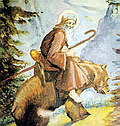 Since the 15th century various people have brought different votive offerings such as memories to accidents, illnesses, and dangers. Many of them are still hanging on the walls along the staircase and the most valuable ones are kept in the sanctuary. Legends were written on the life of St. Romedio and handed on down through the generations up to the present day confirming and strengthening the devotion of the people from Trentino towards the holy man. The most famous one speaks about the bear often portrayed near St. Romedio. The old man wishing to meet his friend Vigilio, the Bishop of Trento, saw his horse torn to pieces by a bear. After his order, the bear was bridled by his disciple Davide, became docile and carried Romedio on its back down to Trento.
Since the 15th century various people have brought different votive offerings such as memories to accidents, illnesses, and dangers. Many of them are still hanging on the walls along the staircase and the most valuable ones are kept in the sanctuary. Legends were written on the life of St. Romedio and handed on down through the generations up to the present day confirming and strengthening the devotion of the people from Trentino towards the holy man. The most famous one speaks about the bear often portrayed near St. Romedio. The old man wishing to meet his friend Vigilio, the Bishop of Trento, saw his horse torn to pieces by a bear. After his order, the bear was bridled by his disciple Davide, became docile and carried Romedio on its back down to Trento.
San Zeno - SS. Martyrs' Basilic
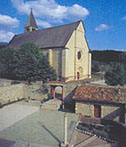 First settled by Retic tribes and later by the Romans, in Sanzeno three young missionaries sent there to evangelise the pagan people by bishop St. Vigilio started their missionary work. In 397 A.D. Martirius, Sisinius, and Alexander were tortured and burnt at the stake. In the place of the execution a chapel and later a basilica were built, which was ended in 1542 by prince-bishop Cristoforo Madruzzo. The Romanesque bell tower with its bricks dating back before the year 1000, the façade, and the gothic-renaissance portal enriches the building with charm and sacred reverence.
Inside, near a nave and two side aisles, it boasts a chapel belonging to the previous church and preserving the shrine with the Saints' relics.
First settled by Retic tribes and later by the Romans, in Sanzeno three young missionaries sent there to evangelise the pagan people by bishop St. Vigilio started their missionary work. In 397 A.D. Martirius, Sisinius, and Alexander were tortured and burnt at the stake. In the place of the execution a chapel and later a basilica were built, which was ended in 1542 by prince-bishop Cristoforo Madruzzo. The Romanesque bell tower with its bricks dating back before the year 1000, the façade, and the gothic-renaissance portal enriches the building with charm and sacred reverence.
Inside, near a nave and two side aisles, it boasts a chapel belonging to the previous church and preserving the shrine with the Saints' relics.
St. Biagio Retreat
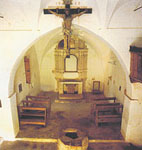 Along the road connecting Revò and Sanzeno, St. Biagio's Church rises on top of a big rock surrounded by some 100 m. deep gorges. Popular legends, partly documented by archaeological finds, recount many historical events, such as the building of a Roman tower, of a lazaret, and later of a retreat for hermits. It seems that St. Biagio himself used to live in this isolated place. The retreat, on whose foundations a church and a convent - today Lanzerotti's House - were built, is very striking and offers to the visitor a rather particular scenery.
Along the road connecting Revò and Sanzeno, St. Biagio's Church rises on top of a big rock surrounded by some 100 m. deep gorges. Popular legends, partly documented by archaeological finds, recount many historical events, such as the building of a Roman tower, of a lazaret, and later of a retreat for hermits. It seems that St. Biagio himself used to live in this isolated place. The retreat, on whose foundations a church and a convent - today Lanzerotti's House - were built, is very striking and offers to the visitor a rather particular scenery.
Father's Kino Memorial
 In the square of Segno a big equestrian statue is found, made by the Mexican sculptor Julian Martinez in memory of Father Eusebio Chini - also known as Kino.
It represents the Jesuit born in Segno and sent by the Holy Spirit to preach the Gospel among the meek poor Indios in the lands of the New World governed by the Spanish Crown during the second half of the 16th century. The monument in Segno is a copy of other two pieces placed in Magdalena, the Mexican city where Father Chini was buried, and in Tucson, Arizona.
In the square of Segno a big equestrian statue is found, made by the Mexican sculptor Julian Martinez in memory of Father Eusebio Chini - also known as Kino.
It represents the Jesuit born in Segno and sent by the Holy Spirit to preach the Gospel among the meek poor Indios in the lands of the New World governed by the Spanish Crown during the second half of the 16th century. The monument in Segno is a copy of other two pieces placed in Magdalena, the Mexican city where Father Chini was buried, and in Tucson, Arizona.
Our Lady of Senale's sanctuary
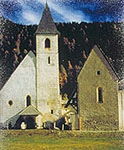 In the year 1184 Pope Lucio III spoke about a so-called 'Our Lady of Senale's Church', which was later rebuilt in 1432. From outside the church seems a simple building, but inside it boasts strikingly rich altars and many pieces of art.
Above the main altar in a golden niche, the Queen of the Woods' miraculous picture from about 1430 stands out to the worship of thousands of pilgrims.
The gothic vault with ogive arch is supported by ten octagonal pillars. The nave is a bit higher than the two side aisles. The present organ from 1868 was made in part out of the previous one arranged in 1668.
There are five baroque altars of great beauty.
Dating back to 1748, the main altar displays a glorification of Mother Mary's and is decorated with a crown of medallions representing the mysteries of the rosary.
There stands out a marvellous Our Lady of Assumption's picture, patron saint of Senale, once placed behind the main altar. The four side altars date back to the period between 1640 and 1720.
The side altar on the right was consecrated to St. Augustine and St. Catherine, whereas the one on the left reminds us of St. Sebastian and St. Rocco's Brotherhood, patrons of the plague.
Furthermore there rise St. Joseph's and Mary's seven pains' altars.
In the year 1184 Pope Lucio III spoke about a so-called 'Our Lady of Senale's Church', which was later rebuilt in 1432. From outside the church seems a simple building, but inside it boasts strikingly rich altars and many pieces of art.
Above the main altar in a golden niche, the Queen of the Woods' miraculous picture from about 1430 stands out to the worship of thousands of pilgrims.
The gothic vault with ogive arch is supported by ten octagonal pillars. The nave is a bit higher than the two side aisles. The present organ from 1868 was made in part out of the previous one arranged in 1668.
There are five baroque altars of great beauty.
Dating back to 1748, the main altar displays a glorification of Mother Mary's and is decorated with a crown of medallions representing the mysteries of the rosary.
There stands out a marvellous Our Lady of Assumption's picture, patron saint of Senale, once placed behind the main altar. The four side altars date back to the period between 1640 and 1720.
The side altar on the right was consecrated to St. Augustine and St. Catherine, whereas the one on the left reminds us of St. Sebastian and St. Rocco's Brotherhood, patrons of the plague.
Furthermore there rise St. Joseph's and Mary's seven pains' altars.
Mary's Basilic sanctuary
 This very old Romanesque church of Early Medieval origin was enlarged in 1335 by the Earls of Altaguardia and consecrated again in 1338.
It boasts three carved and gilded wooden altars, consecrated in the year 1438 by Bishop Vincenzo Negusanzio.
The main altar with its altar-piece representing the Virgin with the Baby, St. Peter and pictures from 1641 is also very interesting. Behind it a wooden simulacrum of Mary with the Baby in her arms may be admired.
The important side altar on the right named after St. Bartolomeo and St. Caterina, known as the Earls' Altar, was conveyed from the castle of Altaguardia. Worth seeing are also the cycle of frescoes from the 15th century called 'Kleine Passion' and the small terracotta panels with a Way of the Cross, realized in 1951 by Carlo Bonacina and preserved in the sacristy. The new bell tower and the sacristy - now demolished - were built in 1496. In 1763 the bell tower was struck and damaged by lightning; during the war a bell was removed and then replaced in 1923. In fact, the bell tower boasts a more recent style than the church. On the south outside wall stands a big fresco representing St. Cristoforo and made round 1470 by Antonio Baschenis.
This very old Romanesque church of Early Medieval origin was enlarged in 1335 by the Earls of Altaguardia and consecrated again in 1338.
It boasts three carved and gilded wooden altars, consecrated in the year 1438 by Bishop Vincenzo Negusanzio.
The main altar with its altar-piece representing the Virgin with the Baby, St. Peter and pictures from 1641 is also very interesting. Behind it a wooden simulacrum of Mary with the Baby in her arms may be admired.
The important side altar on the right named after St. Bartolomeo and St. Caterina, known as the Earls' Altar, was conveyed from the castle of Altaguardia. Worth seeing are also the cycle of frescoes from the 15th century called 'Kleine Passion' and the small terracotta panels with a Way of the Cross, realized in 1951 by Carlo Bonacina and preserved in the sacristy. The new bell tower and the sacristy - now demolished - were built in 1496. In 1763 the bell tower was struck and damaged by lightning; during the war a bell was removed and then replaced in 1923. In fact, the bell tower boasts a more recent style than the church. On the south outside wall stands a big fresco representing St. Cristoforo and made round 1470 by Antonio Baschenis.



